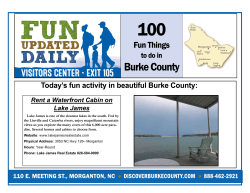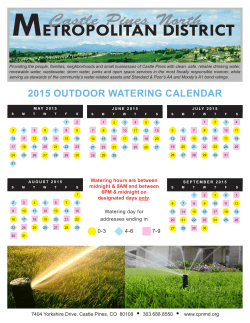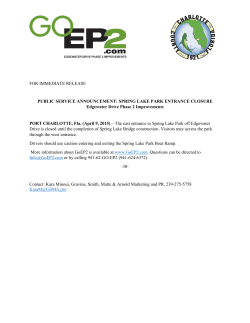
Native Tree Guide - Lake Forest Open Lands Association
PRESRT STD Trees & Utilities US POSTAGE PAID LAKE FOREST, IL PERMIT NO. 64 Shagbark Hickory Redbud Trees are a valuable asset to our community, providing shade, wildlife habitat, and many other environmental benefits — however storms and high winds can damage trees causing power outages. To ensure safe, reliable energy, ComEd recommends planting low-growing native trees and shrubs near power lines. Native trees planted within 20 feet of the power lines should have a mature height of less than 25 feet. In some instances, tall native shrubs may be more appropriate than trees. When selecting trees to be planted within 50 feet of the power lines, consideration should be given to the size and shape of trees that grow larger than 25 feet. Taller trees that come into contact with power lines can also cause power outages. This also ensures that as the tree grows, major trimming will not be necessary. The following native trees can be safely grown around your power lines: Hawthorn American Hornbeam Pagoda Dogwood Blackhaw Viburnum Red Bud Serviceberry Crabapple (select cultivars) Visit www.comed.com/trees for more suggestions on planting the right tree in the right place. Before digging call 8-1-1 (J.U.L.I.E.) to have your underground utilities located. Swamp White Oak Help restore and preserve the landscape character and natural history of Lake Forest by planting native trees and shrubs. ~~~~ For more information contact Peter Gordon, City Forester gordonp@cityoflakeforest.com or 847.810.3563 Quaking Aspen Native trees scattered throughout the community serve as a reminder of the pre-settlement landscape and the beauty of our indigenous forests. Unfortunately, Lake Forest’s native forests and other natural areas are entering a state of decline. Insects and disease such as emerald ash borer (EAB) and Dutch elm disease (DED) have killed tens of thousands of trees. Native trees are not just an environmentally-preferred alternative to the non-native plants commonly used in landscaping, they are typically hardier and better adapted to thrive in Lake Forest. Many native trees produce showy flowers, abundant fruit and have brilliant fall color. Consequently, native trees require less water, fertilizer and pesticides, helping to protect our environment, ground water and one of our greatest assets, Lake Michigan. CONTACT US: City of Lake Forest|800 North Field Drive|Lake Forest, IL 60045|p 847.234.2600|www.cityoflakeforest.com Lake Forest Open Lands|350 North Waukegan Road|Lake Forest , IL 60045|p 847.234.3880|www.LFOLA.org ComEd|ComEd Customer Care Center|P.O. 805379|Chicago, IL 60680|p 800.334.7661|www.comed.com 4 800 North Field Drive • Lake Forest, Illinois 60045 • 847.234.2600 Helpful Tips Start Small Going native can be done in small steps; you don’t have to replant your entire yard all at once. Instead, start small by replacing a non-native tree with a native one, by making a small area of your yard into a native garden, or by replacing a section of turf with native plants. Any piece of your property that you replace with native trees can help bring back the genetic diversity necessary for a balanced ecosystem. “The rapid decline of our abundant ash canopy presents a once-in-alifetime opportunity to “make the right choices” in what we are collectively calling “Re-greening Lake Forest,” and, in a sense give nature a helping hand and “re-set the clock” for our native tree canopy for the next 200 years.” Choose a Variety ~John Sentell President, Lake Forest Open Lands Although many maple species are native to Lake Forest, maples make up nearly 23% of the City’s tree canopy, which is approximately 5% more than the dwindling ash tree population. Therefore, it’s important to plant a diversity of trees. The greater the diversity of tree species within Lake Forest, the less vulnerable it will be to the devastating effects of future pests, pathogens and natural disasters. Follow the 15/10 rule to ensure diversity: No more than 15% in the same genus (“Genus”, i.e. oak, is the collection of species) No more than 10% in the same species (“Species”, i.e. red, refers to the individual type) red oak Consider Alternatives When it comes to planting native trees, most of us think of oaks, maples and lindens. But did you know that there are several other native trees that grow well in Lake Forest? When planting native trees you may want to consider these native alternatives: Black Gum Yellow Birch Yellowwood Kentucky Coffeetree Mockernut Hickory Hackberry Butternut Bald Cypress Northern Catalapa Bitternut Hickory Buckeye Persimmon Ironwood Prairie Crabapple EVERGREENS White Pine Jack Pine Eastern Red Cedar How Much Water? What Size Tree? The amount of water given to newly-planted trees should be carefully measured by slowly applying 1 gallon of water for each diameter inch of trunk every 5 to 7 days. Hot, dry periods, may require watering every 3 to 5 days to keep soil sufficiently moist. Smaller trees establish more quickly and grow faster because fewer roots are lost in transplanting. 2 A Few of Our Favorites For a complete list of native trees, please visit www.cityoflakeforest.com. HAWTHORN: Size: 25’H X Variable spread Growth Habit: Broad and rounded Growth Rate: Medium Color: Green leaves turn bronze-red to purplish red in fall Landscape Value: Plant in groups, screens, or hedges REDBUD: Size: 25’H X 30’W Growth Habit: Flat top to rounded crown Growth Rate: Medium Color: Red/purple flower early spring, leaves have turning yellow in fall Landscape Value: Formal and natural landscapes RED CEDAR; Size: 50’H X 20’W Growth Habit: Pyramidal Growth Rate: Medium Color: Green, year round Landscape Value: Good for grouping, and screens RED OAK: Size: 70’H X 60’W Growth Habit: Roundtopped and symmetrical Growth Rate: Medium Color: Green leaves turn russet-red in fall Landscape Value: Faster growing oak for large areas SHAGBARK HICKORY: Size: 70’H X 40’W Growth Habit: Uniform, broadly oval crown Growth Rate: Slow Fall Color: Yellow/orange Landscape Value: Requires significant space in your landscape to develop WHITE PINE: Size: 70’H X 40”W Growth Habit: Pyramidal in youth, more horizontal branching at maturity Growth Rate: Moderate Color: Green, year round Landscape Value: Great for large properties 3 Helpful Tips Start Small Going native can be done in small steps; you don’t have to replant your entire yard all at once. Instead, start small by replacing a non-native tree with a native one, by making a small area of your yard into a native garden, or by replacing a section of turf with native plants. Any piece of your property that you replace with native trees can help bring back the genetic diversity necessary for a balanced ecosystem. “The rapid decline of our abundant ash canopy presents a once-in-alifetime opportunity to “make the right choices” in what we are collectively calling “Re-greening Lake Forest,” and, in a sense give nature a helping hand and “re-set the clock” for our native tree canopy for the next 200 years.” Choose a Variety ~John Sentell President, Lake Forest Open Lands Although many maple species are native to Lake Forest, maples make up nearly 23% of the City’s tree canopy, which is approximately 5% more than the dwindling ash tree population. Therefore, it’s important to plant a diversity of trees. The greater the diversity of tree species within Lake Forest, the less vulnerable it will be to the devastating effects of future pests, pathogens and natural disasters. Follow the 15/10 rule to ensure diversity: No more than 15% in the same genus (“Genus”, i.e. oak, is the collection of species) No more than 10% in the same species (“Species”, i.e. red, refers to the individual type) red oak Consider Alternatives When it comes to planting native trees, most of us think of oaks, maples and lindens. But did you know that there are several other native trees that grow well in Lake Forest? When planting native trees you may want to consider these native alternatives: Black Gum Yellow Birch Yellowwood Kentucky Coffeetree Mockernut Hickory Hackberry Butternut Bald Cypress Northern Catalapa Bitternut Hickory Buckeye Persimmon Ironwood Prairie Crabapple EVERGREENS White Pine Jack Pine Eastern Red Cedar How Much Water? What Size Tree? The amount of water given to newly-planted trees should be carefully measured by slowly applying 1 gallon of water for each diameter inch of trunk every 5 to 7 days. Hot, dry periods, may require watering every 3 to 5 days to keep soil sufficiently moist. Smaller trees establish more quickly and grow faster because fewer roots are lost in transplanting. 2 A Few of Our Favorites For a complete list of native trees, please visit www.cityoflakeforest.com. HAWTHORN: Size: 25’H X Variable spread Growth Habit: Broad and rounded Growth Rate: Medium Color: Green leaves turn bronze-red to purplish red in fall Landscape Value: Plant in groups, screens, or hedges REDBUD: Size: 25’H X 30’W Growth Habit: Flat top to rounded crown Growth Rate: Medium Color: Red/purple flower early spring, leaves have turning yellow in fall Landscape Value: Formal and natural landscapes RED CEDAR; Size: 50’H X 20’W Growth Habit: Pyramidal Growth Rate: Medium Color: Green, year round Landscape Value: Good for grouping, and screens RED OAK: Size: 70’H X 60’W Growth Habit: Roundtopped and symmetrical Growth Rate: Medium Color: Green leaves turn russet-red in fall Landscape Value: Faster growing oak for large areas SHAGBARK HICKORY: Size: 70’H X 40’W Growth Habit: Uniform, broadly oval crown Growth Rate: Slow Fall Color: Yellow/orange Landscape Value: Requires significant space in your landscape to develop WHITE PINE: Size: 70’H X 40”W Growth Habit: Pyramidal in youth, more horizontal branching at maturity Growth Rate: Moderate Color: Green, year round Landscape Value: Great for large properties 3 PRESRT STD Trees & Utilities US POSTAGE PAID LAKE FOREST, IL PERMIT NO. 64 Shagbark Hickory Redbud Trees are a valuable asset to our community, providing shade, wildlife habitat, and many other environmental benefits — however storms and high winds can damage trees causing power outages. To ensure safe, reliable energy, ComEd recommends planting low-growing native trees and shrubs near power lines. Native trees planted within 20 feet of the power lines should have a mature height of less than 25 feet. In some instances, tall native shrubs may be more appropriate than trees. When selecting trees to be planted within 50 feet of the power lines, consideration should be given to the size and shape of trees that grow larger than 25 feet. Taller trees that come into contact with power lines can also cause power outages. This also ensures that as the tree grows, major trimming will not be necessary. The following native trees can be safely grown around your power lines: Hawthorn American Hornbeam Pagoda Dogwood Blackhaw Viburnum Red Bud Serviceberry Crabapple (select cultivars) Visit www.comed.com/trees for more suggestions on planting the right tree in the right place. Before digging call 8-1-1 (J.U.L.I.E.) to have your underground utilities located. Swamp White Oak Help restore and preserve the landscape character and natural history of Lake Forest by planting native trees and shrubs. ~~~~ For more information contact Peter Gordon, City Forester gordonp@cityoflakeforest.com or 847.810.3563 Quaking Aspen Native trees scattered throughout the community serve as a reminder of the pre-settlement landscape and the beauty of our indigenous forests. Unfortunately, Lake Forest’s native forests and other natural areas are entering a state of decline. Insects and disease such as emerald ash borer (EAB) and Dutch elm disease (DED) have killed tens of thousands of trees. Native trees are not just an environmentally-preferred alternative to the non-native plants commonly used in landscaping, they are typically hardier and better adapted to thrive in Lake Forest. Many native trees produce showy flowers, abundant fruit and have brilliant fall color. Consequently, native trees require less water, fertilizer and pesticides, helping to protect our environment, ground water and one of our greatest assets, Lake Michigan. CONTACT US: City of Lake Forest|800 North Field Drive|Lake Forest, IL 60045|p 847.234.2600|www.cityoflakeforest.com Lake Forest Open Lands|350 North Waukegan Road|Lake Forest , IL 60045|p 847.234.3880|www.LFOLA.org ComEd|ComEd Customer Care Center|P.O. 805379|Chicago, IL 60680|p 800.334.7661|www.comed.com 4 800 North Field Drive • Lake Forest, Illinois 60045 • 847.234.2600
© Copyright 2025









